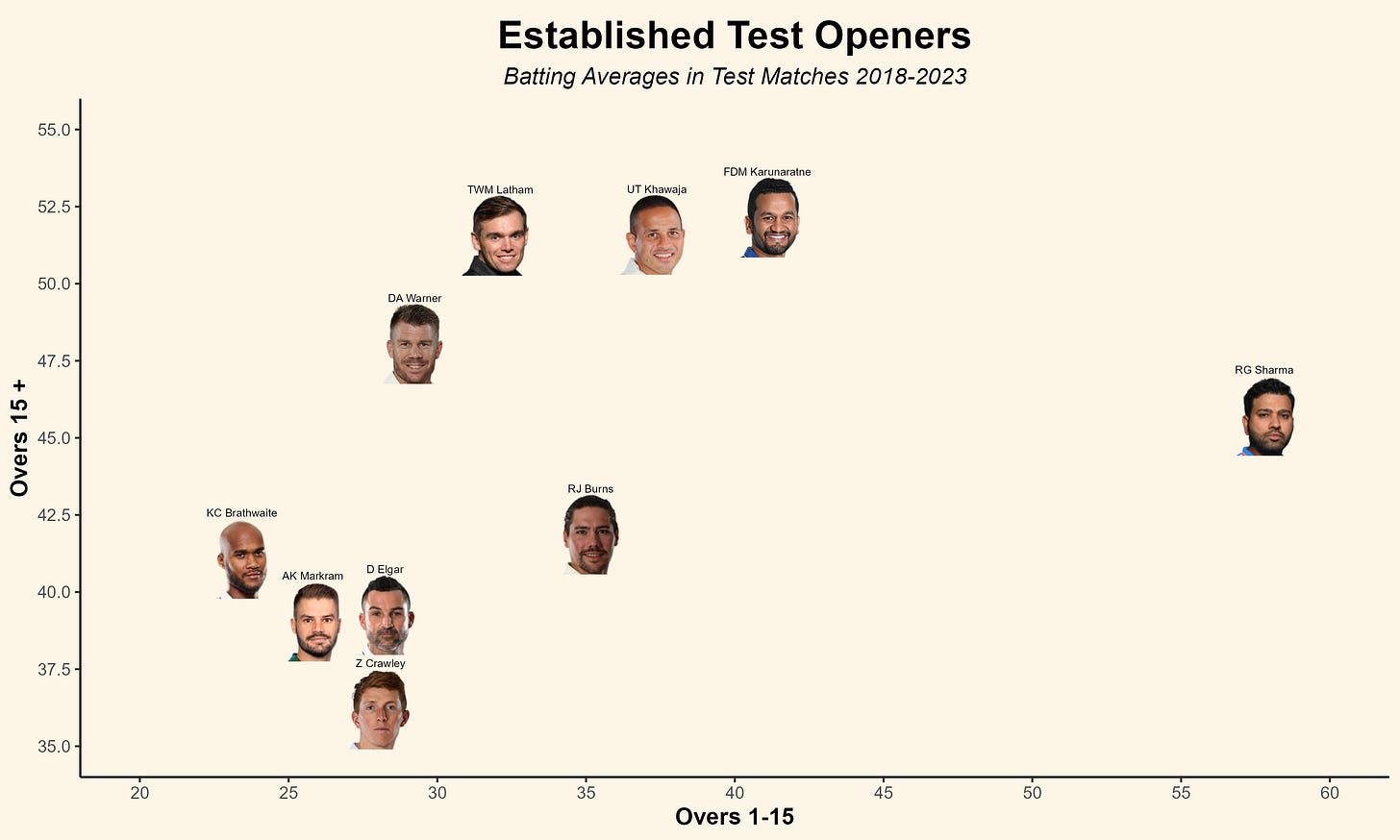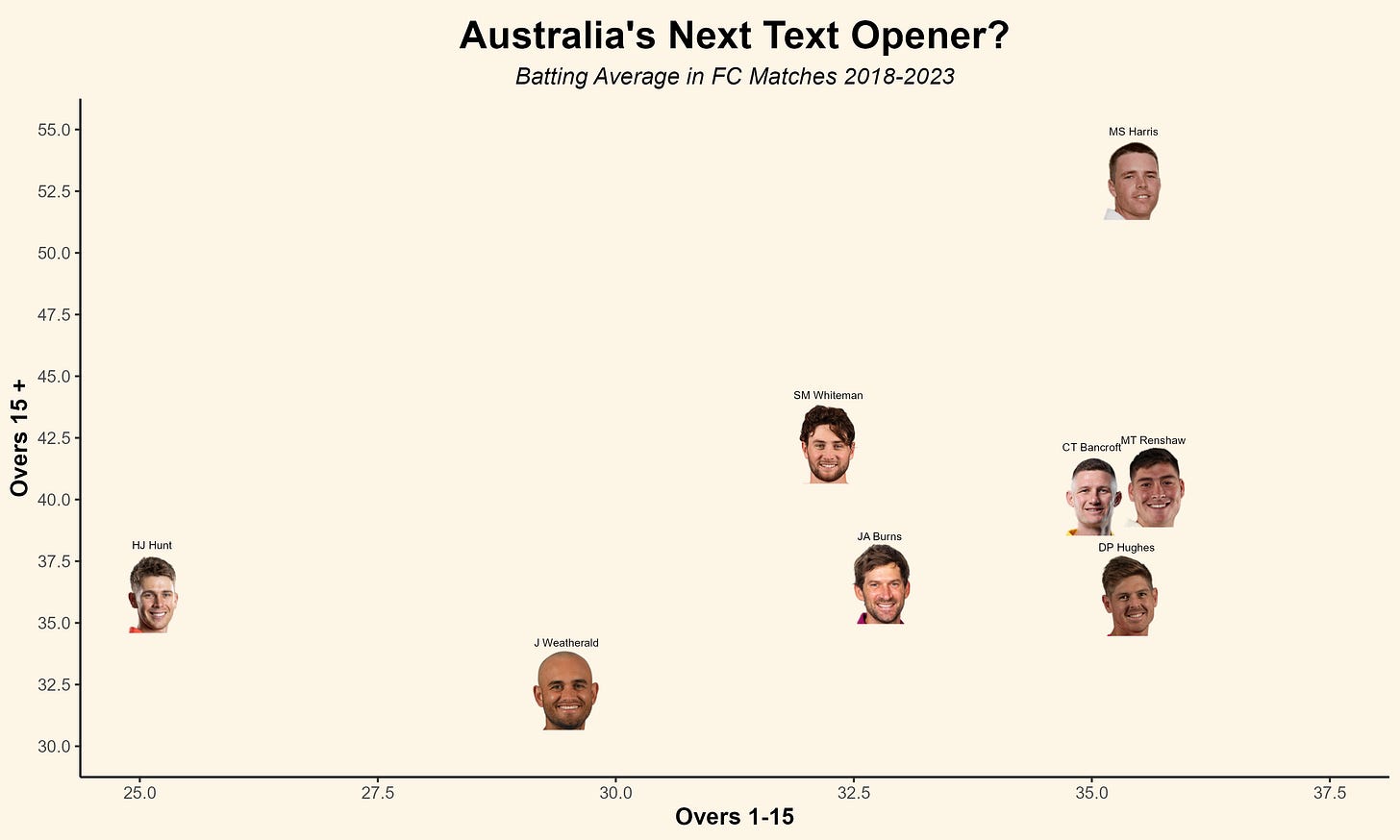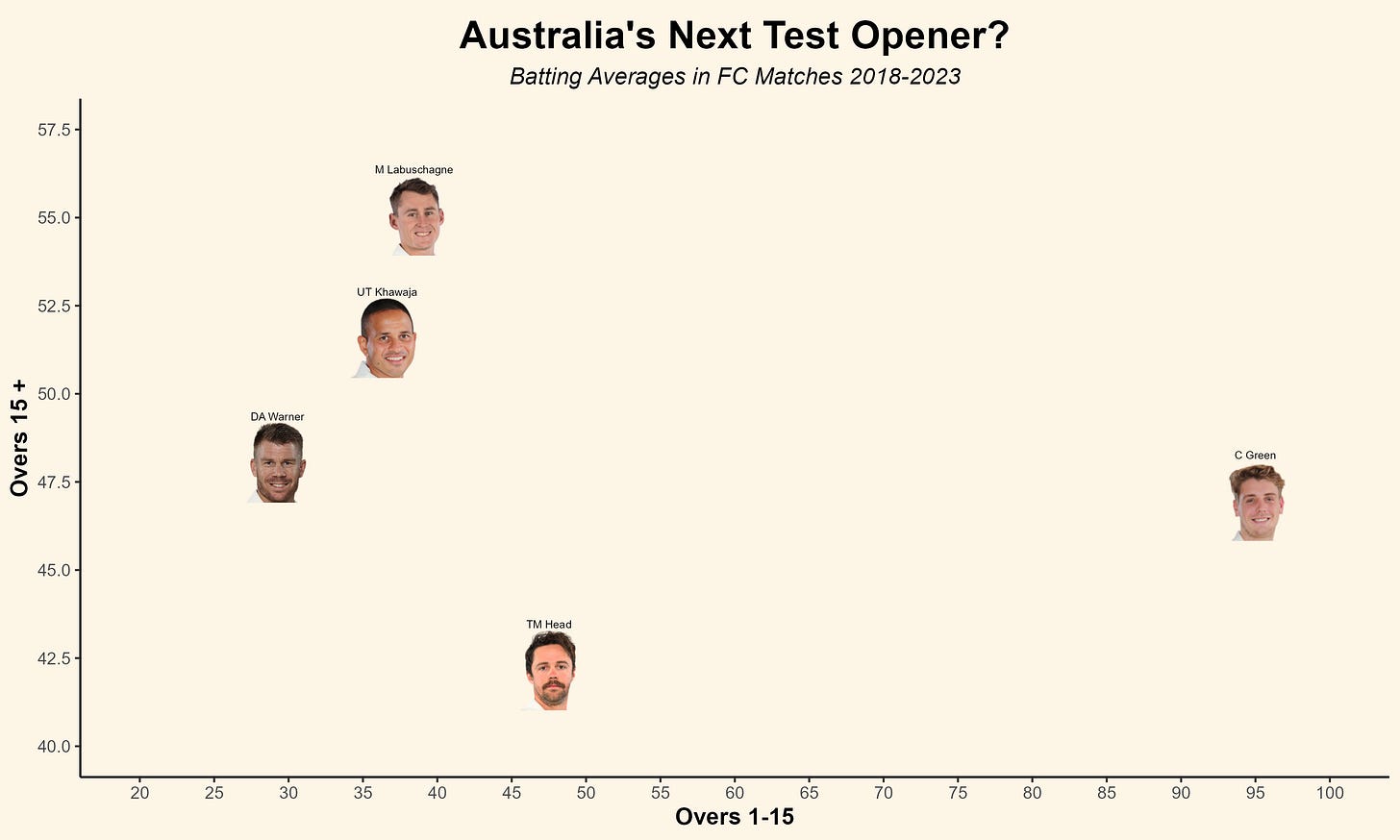There is about to be a crisis at the top of the Australian Men’s Test batting order. Usman Khawaja is 36, and David Warner is 37. So far, the selectors haven’t found an adequate replacement for either. The clock is ticking, but who is ready to step up?
Test Opening Batters
For context, these are the ten Test batters who have faced the most balls in overs 1-15 since 2018. The x-axis, Overs 1-15, reflects a batter’s skill against the new ball. How good are they at surviving the hardest part of the innings? The y-axis, Overs 15+, shows an opener’s ability to turn a start into a big score. The majority of these Test batters average 25-40 against the new ball, and 35-50 against the older ball. Rohit Sharma is a clear outlier, as he dominates the new ball but actually averages less later in the innings.
Recent Form
The following graph considers every FC match in 2022 and 2023 (up to December 5th), both international and domestic, as well as filtering for:
>20 batting average in the first 15 overs
Min. 750 runs in the first 15 overs
>25 batting average in overs 15+
I’ve added both Khawaja and Warner to this graph for the sake of comparison. Most of their data is from Test matches, so any potential replacement would want to be outperforming their averages in domestic cricket, given the lower standard. Warner has been short on runs for years, whereas Khawaja has been in outstanding form.
The standout performer in this graph is Cameron Bancroft. He has been far better against the new ball than all of his competitors. He has done this both in Australian and English conditions, demonstrating an ability to adapt to different conditions as well. Marcus Harris has struggled for form throughout the last two years, mainly against the new ball. However, he has been as prolific as anyone in the middle overs. Matthew Renshaw hasn’t been far behind Harris’ production, meaning he is still under some consideration. He may be better suited to batting in the middle order, like he did in his most recent Test appearance.
The other openers in this dataset haven’t shown enough to be considered for Australian selection. Will Pucovski is a notable exception from this graph, but he didn’t meet the minimum requirements and has barely played in the last couple of years. He’ll need a sustained period of domestic form before he is considered for Australian duty again.
Sustained Performance
In terms of the last five years, Marcus Harris is the outstanding option. He has excelled in both phases of the innings. Bancroft and Renshaw are grouped together, with similar but unremarkable numbers. All three are very comparable against the new ball, but Harris has been far better at turning his starts into substantial contributions.
Makeshift Openers
Is there anyone in the current Test side who could be converted into an opener, given the lack of an obvious replacement? Let’s look at the data on Head, Green, and Labuschagne against the new ball, without any of the previous restrictions.
Cameron Green has faced just 173 balls in the first 15 overs. Just 2 of those balls were in a Test match. Nonetheless, he is 95/1 in this incredibly small sample size. Travis Head has more experience against the new ball, facing 928 balls, of which 33% have been in Tests. His record is also extremely impressive, having averaged more than 45 against the new ball. Head actually averages less when the ball gets older, indicating he might be best used as an opener. Labuschagne has faced just as many balls as Khawaja and Warner, as he mostly bats #3, and thus faces the new ball whenever an early wicket falls. Interestingly, in Tests only, he averages 71 in the first 15 overs. But this trend isn’t reflected in his domestic statistics at all.
The Verdict
1 - Marcus Harris
Harris has been the outstanding opener in Australian domestic cricket for the last five years. In his Tests so far, he averages 29 against the new ball, but just 21 against the old ball. 29 against the new ball is perfectly acceptable, as demonstrated in the first graph. His average of 21 in the middle overs doesn’t match his dominant performances in domestic cricket, where he has averaged over 50 in this period for several years. I would back him to continue to average around 30 against the new ball, but to increase his average in overs 15+ to at least 40. In the PMXI bat-off against Pakistan, he made 49.
2 - Cameron Bancroft
Bancroft’s Test record is virtually identical to Harris’; he also averages 29 and 21. He is also the form opener, with a better record recently than Harris. However, Harris pips him across the last five years, and Bancroft fails my ‘eye-test’. Whereas Harris looks balanced and tidy, Bancroft seems to be forever falling across the crease and squirting his defensive shots out towards point. Bancroft and Harris are hard to split, but I would personally take Harris first. In the PMXI bat-off against Pakistan, he made 53.
3 - Travis Head
Travis Head has shown an impressive ability to face the new ball in both domestic and international matches, albeit with a small sample size. In Tests he averages 53 and strikes at 69 against the new ball. For South Australia he averages 101 against the new ball. I think he is the strongest option, but it means that Australia loses their prized #5. This would mean they still have to find another batter, and it would further complicate matters if Head stumbled in his new role. If it’s not broke, don’t fix it, I’d keep Head at 5.
4 - Matthew Renshaw
Renshaw played a handful of Tests in 2016 and 2017, which didn’t make the sample for the above visualisations. However, in his early 20s, he arguably looked more comfortable than Harris and Bancroft at Test level. Taking all of Renshaw’s Tests into account, he averages 22 against the new ball, and 36 against the old ball. Similar to his domestic stats, it seems like Renshaw is best placed to bat in the middle order. He could potentially replace Travis Head at #5 if Head was to open the batting. In the PMXI bat-off against Pakistan, he made 136*.
5 - Marnus Labuschagne
Labuschagne’s average of 71 against the new ball in Test cricket is extremely high, but it is 16 in Shield cricket and 37 in County cricket, since 2018. Of course, Labuschagne is adept at facing the new ball, but this is a necessary trait of any decent #3. There is no real reason to slide him up the order, as he is more comfortable batting later on in the innings.
6 - Cameron Green
It would be extremely harsh to elevate Green to the hardest role in Test cricket. He has practically no experience facing the new ball in long-form cricket. He should keep finding his feet at #6 in the order.







